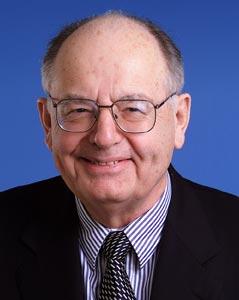
It is one thing to determine the structure of a complex molecule like DNA—which if stretched straight would be some two meters long—or Vitamin B12; it is another to make analogs of such biologically-important things and understand them so well as to know why they formed in nature as they did. Through his seminal efforts devising how to create such complicated molecules in the lab, Albert Eschenmoser has begun to answer the question of why RNA and DNA have the shape they do.
Born in Erstfeld, Switzerland in 1925, Eschenmoser's first academic ambition was to become a secondary school teacher, but when he landed at the Swiss Federal Institute of Technology in Zürich (ETH) for college he soon found a mentor—Nobel Prize winning chemist Lavoslav Ruzicka—who set him on a different path. Eschenmoser earned his doctorate in chemistry from ETH in 1951, at which point he began teaching and conducting research there. His interests turned towards synthesizing molecules. His first major success was to synthesize the gout medicine colchicine, but Eschenmoser truly made a name for himself when in 1972, with Robert Woodward, he synthesized Vitamin B12, which remains one of the major accomplishments in chemical synthesis to this day.
Now a professor emeritus at ETH and a professor at The Scripps Research Institute, Eschenmoser has spent much of his later career on what he calls "chemical etiology"—the systematic attempt to determine why nature chose certain molecular structures for gene carrying, out of all the possible structures. This should, he believes, also help guide a theory on the origin of life on earth. Towards this end, he has investigated ribose (the "R" in RNA) synthesis and synthesized alternative backbone structures for DNA and RNA. In studying these, he discovered that nature's structures are not the only possible ones, opening up the question of how DNA and RNA ended up with these structures-the optimal ones for replication, thus enabling life.
As testament to his pervasive contributions, Eschenmoser's name is attached to several chemical synthesis techniques and ingredients such as Eschenmoser's Salt and the Eschenmoser Sulfide Contraction. His numerous academic awards include the American Chemical Society [ACS ] Fritzsche Award, the Royal Society's Davy Medal, The Tetrahedron Prize for Creativity in Organic Chemistry, the ACS Arthur C. Cope Award, the International Society for the Study of the Origin of Life's Al Oparin Medal, the ACS Roger Adams Award and the Royal Society of Chemistry's Sir Derek Barton Gold Medal.
Information as of April 2008

